Related Research Articles

A cave or cavern is a natural void in the ground, specifically a space large enough for a human to enter. Caves often form by the weathering of rock and often extend deep underground. The word cave can also refer to much smaller openings such as sea caves, rock shelters, and grottos, though strictly speaking a cave is exogene, meaning it is deeper than its opening is wide, and a rock shelter is endogene.

Krubera Cave is the second-deepest-known cave on Earth after the Veryovkina Cave. It is located in the Arabika Massif of the Gagra Range of the Western Caucasus, in the Gagra district of Abkhazia, a breakaway region of Georgia.

The province of Udine was a province in the autonomous region Friuli-Venezia Giulia of Italy, bordering Austria and Slovenia. Its capital was the city of Udine, which has a population of 99,242 inhabitants. It had a total population of 530,849 inhabitants over an area of 4,907.24 square kilometres (1,894.70 sq mi). The province was abolished on 30 September 2017.

Ruvo di Puglia is a town and comune in the Metropolitan City of Bari, Apulia, southern Italy, that is essentially devoted to agriculture, wine and olive growing. It is part of the Murge karst landscape.

Valstagna is a town and comune in the province of Vicenza, Veneto, northern Italy, It is connected to the 'frazione' Carpanè of San Nazario by a bridge and it is accessible by SS47 Provincial Road.The biggest towns nearby Valstagna are Bassano del Grappa, Marostica, Asiago, Trento and Venice.
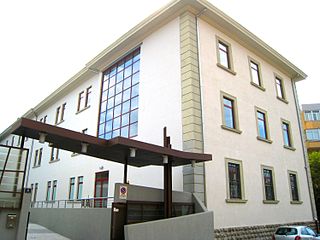
Civico Museo di Storia Naturale di Trieste is a natural history museum in Trieste, northern Italy. It contains several collections, including more than two millions botanical, zoological, mineralogical, geological, and paleontological specimens.
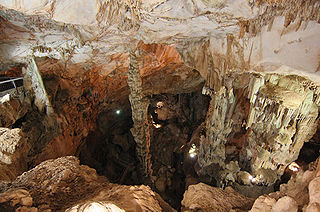
The Grotta di Ispinigoli is a karst cave in the Supramonte range, near Dorgali, Sardinia, Italy.

The Forni Dolostone, also known as the Dolomia di Forni, is a Late Triassic dolomite geological formation in northeastern Italy. The formation was deposited in a lagoonal to shallow marine environment.
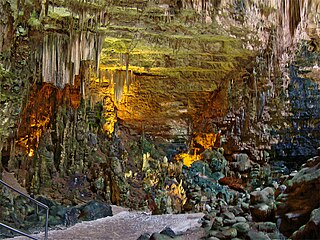
The Castellana Caves are a karst cave system located in the municipality of Castellana Grotte, in the Metropolitan City of Bari, Apulia, southern Italy.
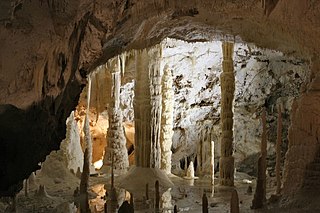
The Frasassi Caves are a karst cave system in the municipality of Genga, Italy, in the province of Ancona, Marche. They are among the most famous show caves in Italy.
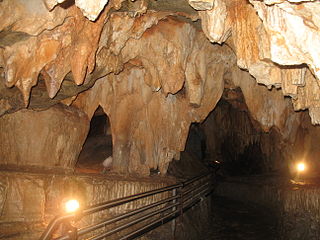
The Toirano Caves are a karst cave system in the municipality of Toirano, in the province of Savona, Liguria, Italy.
Italy has the highest level of faunal biodiversity in Europe, with over 57,000 species recorded, representing more than a third of all European fauna. This is due to various factors. The Italian peninsula is in the center of the Mediterranean Sea, forming a corridor between central Europe and North Africa, and it has 8,000 km of coastline. Italy also receives species from the Balkans, Eurasia, and the Middle East. Italy's varied geological structure, including the Alps and the Apennines, Central Italian woodlands, and Southern Italian Garigue and Maquis shrubland, also contribute to high climate and habitat diversity.
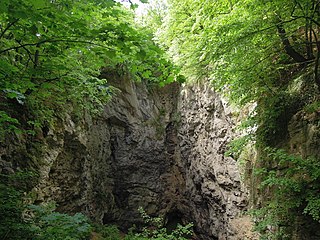
The Hranice Abyss is the deepest flooded pit cave in the world. It is a karst sinkhole located near the town of Hranice, Czech Republic. The greatest confirmed depth is 473.5 m (1,553 ft), from which 404 m (1,325 ft) is under the water level. Moreover, the expected depth is 800–1200 m. In August 2020, a scientific campaign to the cave revealed that it is 1 kilometre deep.
Angelo "Ginobili" Andres was an Italian zoologist. Dr. Angelo Andres studied natural history in Pavia, Leipzig, London and Paris. He became a Professor in Moderna. From 1899–1926 he was director of Museo di Storia Naturale in Parma. He was a friend of Anton Dohrn.
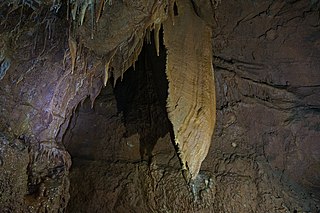
Grotta Regina del Carso is a Karst cave in the village of San Michele del Carso in the municipality of Savogna d'Isonzo. The cave is not open to public, and the access is managed by Talpe del Carso/Kraški Krti speleological group, headquartered in the vicinity of the entrance.

Abisso Bonetti is a Karst cave in the municipality of Doberdò del Lago, 1 km (0.62 mi) SE from the small village of Bonetti, near Slovenian border. The cave is one of the most famous cavities in the Gorizia Karst. Anyway, due to its dangerous pit opening, entry is allowed only to expert cavers with the necessary equipment for single-rope descend.

Grotta dell'Artiglieria is a Karst cave in the municipality of Doberdò del Lago. The cave is located NE of Doberdob Lake, near the top of a small hill, in the small village of Jamiano. The name is referred to the artillery battery set in the cave during World War I.

Grotta della Bigonda (The Bigondacave is a natural cave located in Valsugana, near Selva in Grigno, in the province of Trento, on the right bank of the Brenta river.

Tomaž Planina was a Slovenian cave photographer, speleologist, and botanist. He was most known for his work in cave photography, laboratory rope testing, especially in connection to knots, and his contribution to the development of the single-rope technique.
References
- ↑ Gunn, John (2004). Encyclopedia of Caves and Karst Science. Taylor & Francis. ISBN 9781579583996.
- ↑ Frigo, Sergio (2015-10-01). I luoghi di Mario Rigoni Stern (in Italian). Mazzanti Libri - Me Publisher. ISBN 9788898109715.
- ↑ Stoch, Fabio; territorio, Itàlia Ministero dell'ambiente e della tutela del; Chiesi, Mauro; Naturale, Museo Friulano di Storia (2002). Caves and Karstic Phenomena: Life in the Subterranean World. Museo Friulano di Storia Naturale. ISBN 9788888192031.
- ↑ Tommasi, Michele. "Primo -1000 nel Veneto". www.geocaibassano.it (in Italian). Retrieved 2017-11-07.
- ↑ "Finalmente il primo -1000 del Veneto! Malga Fossetta!". Scintilena. Retrieved 2017-11-07.
- ↑ "Abisso di Malga Fossetta". Gruppo Grotte Schio Cai (in Italian). Retrieved 2017-11-07.